
Contents
4. Method of performing Tarpan
4. Pitrutirtha: When should it be done?
5. Tarpanof sesame seeds (tila tarpan)
6. Importance of performing tila tarpan
1. Terminology of Shraddha
A) Pitar
When a human being dies, its subtle body gets freed from the dead body after performing the ritual of Shraddha and it gets position in the subtle plane meant for souls of dead persons. At that moment it assumes the designation of Pitar.
B) Parvan
After performing Sapindikaran Shraddha (Shraddha performed one day prior to one-year completion after the death of the person is called Sapindikaran Shraddha), the soul that has assumed the designation of Pitar now joins other Pitars and then gets further categorised as Parvan. Also, it gains authority so as to allow its descendants to perform Parvan Shraddha for it.
C) Pitrutrayi (Trio in Pitars)
Generally son of the dead person has authority to perform Shraddha for the dead person. In his absence, other options are explored. The terminology of Shraddha has been prepared assuming the son as being the person who performs the shraddha. Therefore the soul of dead person for whom the Shraddha is being performed, is invoked as ‘pita’ (father of the son performing Shraddha). One generation before, i.e. the father of dead person is referenced as ‘Pitamaha’ (grandfather of the son performing Shraddha). The grandfather of the dead person is referred to as ‘Prapitamaha’ (great grandfather of the son performing Shraddha). The earlier generations than these are not counted in trios of Pitars (Pitrutrayi), because it is assumed that they are liberated.
D) Jivatpitruk
When there is a male person whose father is alive, then such a person does not have authority to perform Shraddha. But he has right to perform Shraddha for his mother and grandfather (mother’s father). Also, generally, he even does not have the right to perform rituals of Narayannagbali, Tripindi etc; however if these rituals are performed with the objective of conceiving a child, then the jivatpitruk can do so. In order to perform ‘Apasavya’, a jivatpitruk can only hold the thread in the thumb of the left hand and cannot hold it completely in his left hand.
E) Three ways of wearing the thread (janve) are Savya, Apasavya and Nivit
The thread should always be worn on the left shoulder. This style of wearing the thread is known as ‘savya’. When it is worn on the right shoulder it is known as ‘Apasavya’. When worn as a necklace, it is known as ‘Nivit’.
F) Offering ‘kshan’
During the ritual of shraddha, the deity and the deceased ancestors’ soul are invited by offering grass twigs (darbha) to them. This is called the offering ‘kshan’.
G) Pishangi
Rangoli drawn using ash and with chanting of mantras around the meal plate arranged for the priest (Brahmin) is called as pishangi. (Offering food to priest (Brahmin) is considered as an important part of Shraddha). Rangoli is drawn in a clockwise direction (similar to circumambulation) around the food offering plate arranged for the deity and in the reverse direction around the plate arranged for the ancestors’ soul. Pishangi is one of the aspects of the ritual of shraddha. Nowadays, Pishangi is drawn only in case of offering of Pinda (Pinda daan). However, Pishangi should be drawn during all types of shraddha.
H) Vikir
During Shraddha, after finishing offering of Pinda (Pinda daan) and worship of Pinda, ‘Savya’ is performed and a morsel of rice is kept in front of the plate with the food offering arranged for the Deity. This is termed as Vikir.
I) Prakir
After performing Vikir, ‘Apasavya’ is done and a morsel of rice is kept in front of the plate which has the meal arranged for deceased ancestors’ soul. This is called as Prakir.
J) Ucchista Pinda
After performing Prakir, pinda is kept for the ones who have died by getting burnt in a fire or due to partial burning, or for the dead foetus, near the plate of food arranged for the deceased ancestors’ soul or close to other offerings of pinda.
K) Shraddha Sampat
If two shraddhas occur on the same date (as per Hindu calendar) then it is termed as Shraddha Sampat.
2. Tarpan and Pitru tarpan
2.1 Tarpan
‘Trup’ means satisfying others. The word ‘Tarpan’ has been formed from the root word ‘Trup’. Offering water to God, Sages, ancestors’ soul and human beings and satisfying them through it is called tarpan.
The objective of performing tarpan is that God, deceased ancestors’ souls etc. whose names are pronounced while performing Tarpan, should bestow happiness on us.
Brahmayadnyang (performed during sacrificial fires), snanang (performed daily after bath), shraddhang (performed during Shraddha) are the various types of Tarpans that are part of the various rituals and should be performed during the respective occasions.
D) Method of performing Tarpan
1. Bodhayan has mentioned that ‘Tarpan should be performed at the riverside’. While performing Tarpan at the riverside, one should stand in the river so that the water level touches the belly button or one should perform tarpan by sitting on the banks of the river.
2. Tarpan for God and Sages should be performed by facing East and that for deceased ancestors’ souls it should be performed by facing South.
3. As per science, tarpan for God should be performed after doing ‘Savya’, that for Sages should be performed after doing ‘Nivit’ and for deceased ancestors’ souls after doing ‘Apasavya’.
4. A dried grass twig (darbha) is necessary for performing tarpan. Tarpan for God is performed from the tip of the darbha, tarpan for Sages should be performed by folding the darbha in the middle, and tarpan for deceased ancestors’ souls should be performed from the tip and root of the two darbhas.
5. Offering of water (tarpan) to deities should be done using the finger tips, while offering of water to Sages should be done from the base of the little finger and the third finger and that to the deceased ancestors’ souls should be done through the mid of the thumb and the first finger of the hand.
6. Tarpan should be performed taking one handful (anjali) of water for each deity, two handful of water for Sages and three handful of water for deceased ancestors’ souls. In case of matrutrayi (mother, grandmother and great grandmother) three handful of water should be used and for other females ancestors’ souls one handful of water should be used for tarpan.(8)
(Original meaning of word ‘anjali’ is handful (‘onjal’). In this context, however, ‘giving one handful (anjali) of water for tarpan’ is to indicate that the tarpan should be given only once – Compiler)
2.2. Pitru tarpan
Offering of water to deceased ancestors’ souls (pitar) is called as Pitru tarpan. A Jivatpitruk is not allowed to perform Pitrutarpan.
Apart from expectation of Pinda and offering of food to priests (Brahmins) from its descendants, the deceased ancestors’ souls also expect offering of water (udak) from them.
By performing tarpan, the deceased ancestors’ souls not only get satisfied and leave us, but they also bestow long life, radiance, superior intellect (brahmavarchaswa), wealth, success and foodstuff (ability to digest the food consumed) on the host performing the tarpan and satisfies him too.
When should it be done?
1. Tarpan for God, Sages and deceased ancestors’ souls should be performed regularly (daily). The daily ritual of tarpan should be accomplished in the early morning after having bath. If it is not possible to perform Shraddha for deceased ancestors’ souls daily, then one should at least perform tarpan.
2. Pitru tarpan should be performed on the day following the day on which Parvan Shraddha is performed.
E) Tarpan of sesame seeds (tila tarpan)
Sesame seeds should be used in the ritual of Pitru tarpan. Sesame seeds are available in two varieties, black and white. Black sesame seeds should be used for Shraddha.
1. Tila tarpan means offering sesame seeds mixed in water to the deceased ancestors’ souls.
2. Tila tarpan (as a part of Shraddha) should be offered to the same number of ancestors’ souls for whom the shraddha has been performed.
3. Tila tarpan is performed before Darsha shraddha and in case of annual shraddha; tila tarpan is performed on the following day of the shraddha. In case of any other shraddha, tila tarpan is performed just after performing the shraddha.
4. Tila tarpan is not performed during Nandi Shraddha, Sapindi Shraddha etc. (9)
F) Importance of performing tila tarpan
1. Sesame seeds are the favorites of deceased ancestors’ souls.
2. On the day of Shraddha, sesame seeds should be sprinkled all over the house, sesame seeds mixed in water should be given to the invited priests (Brahmins) and sesame seeds should be donated. – Jaiminiya Ghruya sutra (2.1), Boudhayan Dharmasutra (2.8.8) and Boudhayan Ghruya sutra


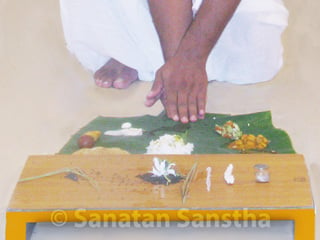 Method of serving food during Shraddha ritual
Method of serving food during Shraddha ritual Traditions observed in different countries for the liberation of deceased ancestors
Traditions observed in different countries for the liberation of deceased ancestors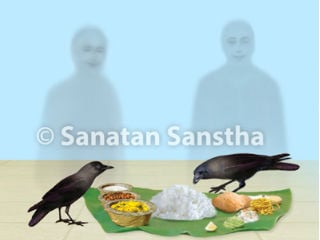 How to perform Mahalaya shraddha in Pitrupaksha during the Coronavirus pandemic ?
How to perform Mahalaya shraddha in Pitrupaksha during the Coronavirus pandemic ?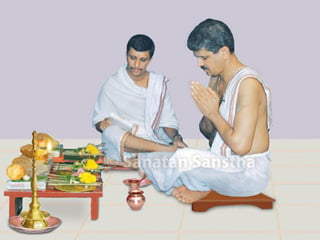 What are three historically established phases of Shraddha?
What are three historically established phases of Shraddha?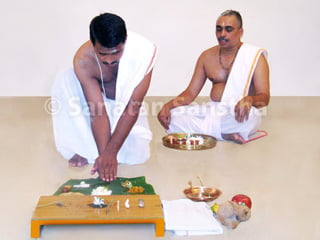 When should the Shraddha be performed ?
When should the Shraddha be performed ?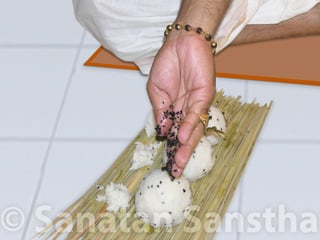 When can women perform Shraddha ?
When can women perform Shraddha ?
can father performed shraddha of his son
Namaskar Nandiniji,
Yes, a father can perform shraddha of his son.
Can a girl perform tarpan during pitra paksha
Yes, a girl can perform Tarpan.
can grandson perform tila tarpan at home for his grandfather ,,or my father only has to do it BY HIMSELF
Yes, a grandson can perform Tiltarpan for his grandfather, under below conditions –
1. Upanayan sanskar has been performed on grandson
2. During apasavya he should hold his yadnyopavit in his left hand’s thumb.
Namaskar.
Can a younger brother perform shraddha or tarpan for his elder brother who passed away few months before in hospital in thu pandemic because of I’ll treatment by the hospital staff.
Namaskar,
As per Dharmashastra, an individual does not have the right to perform shraddha until his father is alive. If your father is alive, then you cannot perform shraddha of your brother, else you can perform his shraddha.
Father left last year in hospital during pandemic . Son in America unable to perform rituals , daughter in India is eager , is she allowed to do ? What aspects shd she follow ?
Namaskar,
Please see if the son can perform Shraddha as per any one of the alternatives (prescribed in the Dharmashastras) given on the following link : https://www.sanatan.org/en/a/109582.html
Can a married women having husband & sin can perform tarpan to her father and mother individually
Namaskar,
Women cannot perform tarpan, since their thread ceremony is not performed.
Thank you for detail explanation.
Question: Can a son perform Pitru Tarpan even if his father is alive? This is because I was told that I have a Pitru Dosh in my horoscope with few weak planets, we had 3 miscarriages.
Namaskar,
Does your father perform Pitru tarpan? If yes, then you (son) get(s) the benefit of that tarpan.
Doing Pitru tarpan is not the only solution to get rid off Pitru dosh. For Pitru dosh nivaran, you can do the Deity Datta chant as follows – ‘Shri Gurudev Datta |’ For more details regarding this chant, visit – https://www.sanatan.org/en/a/130.html
My father left 2month ago can i perform tarpon ritusls for my father?
Namaskar,
Shraddha should be performed every month till one year is completed after an individual passes away. While performing Shraddha, tarpan is also performed.
Can tarpon be done during one year of deceased
Namaskar,
Yes, Shraddha should be performed every month till one year is completed after an individual passes away. While performing Shraddha, tarpan is also performed.
Whether sesame til with water after tharpanam can be poured into the garden gras?
Namaskar Shri. Srinivasan ji,
You can offer the sesame water to garden grass or plants in the garden, if nobody steps on it, that is care should be taken that you do not dishonor it.
Can i do simple tarpan at home daily.my father is alive.i am vaishya no thread.i saw video in jaggannath hora in that video they said u can do tarpan daily even if your father alive
Namaskar,
As you might know, there are 3 types of tarpan. Tarpan is done for God, sages (hrishis) and ancestors. While performing tarpan, it is necessary to consider which one of the 3 tarpan you want to do, whether your father is alive, is your thread ceremony done etc. Depending on these aspects the procedure of your performing the tarpan will depend. Hence, we request you to contact a local purohit, discuss these things and learn the procedure from him that prevails for your conditions.
Namaskar. During pitru paksha or Mayalaya amavasya, should pinda daan be done for ancestors along with tarpan? or only tarpan to be done with water and til? if pinda daan is to be done, whether brahmins should be invited and fed? kindly guide these aspects.
Namaskar Shri. Mithun ji,
Yes, Pinda daan should be done for ancestors during pitru paksha.
Yes, brahmins should be invited for food. If there is any difficulty in getting the required number of brahmins then ‘Chat Shraddha’ is performed.
Can we perform Lakshmi pooja In the evening after doing Tharpanam in the afternoon.
Namaskar Shri. Bhaskara Soma Shekhar ji,
If you are doing nitya tarpan, then you can do tarpan and perform Lakshmi pooja in the evening.
Namaste,
Can i give daily Tarpan(Offering water) just after bath and do same from Bathroom ?.
Pls email me answer as i am a temporary visitor on this portal.
Krushna
Namaskar,
Yes, tarpan can be given daily. If you are a Jivatpitruk (that is your father is alive) then you cannot do tarpan for ancestors, that is pitru-tarpan.
Tarpan is a ritualistic offering. In bathroom we cleanse ourselves, hence there is raja-tama over there. Doing ritualistic worship in such a place will not bear any fruit. Also, during the ritual we call the Deities, hrishis, ancestors to partake the offering, so bathroom is not a suitable place for this ritual.
My father passed away on december,2021…can I perform tarpan in upcoming mahalaya on 25th September,2022???
Namaskar,
As per Dharmashastra, mahalay shraddha for the deceased can be performed only after 1 year has completed for the demise. Hence, you cannot perform tarpan or shraddha in this year’s pitrupaksha.
thnx….but my local purohit says that as we have conducted batsarik(varshi)along with the shraddh at the time of shhraddh i.e on 11th day from demise….so we can do tarpan…plz clear my confusion??
thanx
Namaskar,
If the ritual of sapindikaran is done, then there is no problem in doing tarpan and that too if the same purohit (priest) who did the post-death rites is telling that you can do the tarpan ritual now, then you can surely do it accordingly.
We had given that answer because generally according to the prevailing practices certain types of Shraddha are not done within a year so the deceased has not got a place in the Pitru Lok and hence it was told to not offer Tarpan. But if these rituals have already been done then there is no objection to do Tarpan (as per the guidance of local purohit (priests).
Namaskar,
My father is alive but mother has passed away. Can I do tharpanam for my mother? If yes, what type? Amavasya tharpanam? Or annually once during Shraadh?
Regards,
Ravi
Namaskar,
If your father is unable to do tarpan, then after seeking guidance from a purohit you can do ‘Putra Tarpan’.
తిల తర్పణం ఉదయం ఇవ్వవచ్చా? లేక 12.30pm timeలో మాత్రమే ఇవ్వాలా?
Namaskar Shri. Venkatesulu K. ji,
It depends on which method you are using for doing Tarpan. Hence, it would be more appropriate if you learn about the complete method from a learned (along with the rules) and then perform it.
We have performed shraddha and tarpan at Gaya after the passing away of both our parents. What kind of tarpan/shraddha should we do henceforth?
Namaste Archana ji
Thank you for contacting us.
The male member in your family can perform the Shraddha and other rituals. If there is no male member available, then there are other options mentioned in the scriptures that can be employed. Some of these options are mentioned in the following article – https://www.sanatan.org/en/a/80.html
We hope this helps.
Warm regards,
Sanatan Sanstha
ವರ್ಷದಲ್ಲಿ ಎಷ್ಟು ಸಲಿ ಶ್ರಾದ್ಧ ಮಾಡಬೇಕು???
ನಮಸ್ತೆ ಅನುರವಿಯವರೇ
ಈ ವಿಷಯದಲ್ಲಿ ವಿವಿಧ ಪ್ರಾಂತಗಳಿಗನುಸಾರ ವಿವಿಧ ಮತಗಳಿವೆ. ಆದರೆ ಸಾಮಾನ್ಯವಾಯಿಗಿ ಕನಿಷ್ಠಪಕ್ಷ ಪಿತೃಪಕ್ಷದಲ್ಲಿ ಶ್ರಾದ್ಧ ಮತ್ತು ವಾರ್ಷಿಕ ಶ್ರಾದ್ಧವನ್ನಾದರೂ ಮಾಡಲೇಬೇಕು.
ಇಂತಿ,
ಸನಾತನ ಸಂಸ್ಥೆ
We did pitru tarpana at Tilatarapanpuri temple. Some people say that one should take bath after doing pitru tarpana but we did not take bath. I am confused about this matter please answer me.
Namaskar
Offering tarpan also bears the same types of fruits as the ritual of Shraddha does. So it is necessary to bathe after offering tarpan and before doing any everyday work. However, if you have not bathed after tarpan rituals and then offered Puja to some Deity, then you can seek forgiveness from that particular Deity.
Warm regards,
Sanatan Sanstha
ನಾವು ಪಿತೃ ತರ್ಪಣ ಮಾಡಿದ ನಂತರ ಸ್ನಾನ ಮಾಡಲಿಲ್ಲ. ಆದರೆ ದೇವಸ್ಥಾನಕ್ಕೆ ಹೋಗದೆ ನೇರವಾಗಿ ಮನೆಗೆ ಬಂದು ದೈನಂದಿನ ಕಾರ್ಯದಲ್ಲಿ ತೊಡಗಿದೆವು. ಸ್ನಾನ ಮಾಡದ್ದರಿಂದ ಎನಾದರೂ ದೋಷ ತೊಂದರೆ ಆಗುತ್ತಾ?
ಪಿತೃ ತರ್ಪಣ ಮಾಡಿದ ನಂತರ ಸ್ನಾನ ಮಾಡದೆ ನೇರವಾಗಿ ಮನೆಗೆ ಹೋಗಿ ದೈನಂದಿನ ಕಾರ್ಯದಲ್ಲಿ ತೊಡಗಿದೆವು, ಇದರಿಂದ ಏನಾದರೂ ದೋಷ ಬರುತ್ತಾ?
ನಮಸ್ಕಾರ ಮಂಜುಳಾ ರವರೇ
ಹೀಗೆ ಮಾಡುವುದರಿಂದ ಒಂದು ರೀತಿಯಲ್ಲಿ ದೋಷ ತಗಲುತ್ತದೆ. ಆದರೆ ಅದಕ್ಕೆ ದೇವರಲ್ಲಿ ಕ್ಷಮೆ ಕೋರಿದರೆ ಸಾಕು, ಬೇರೆ ಪರಿಹಾರೋಪಾಯ ಮಾಡುವ ಆವಶ್ಯಕತೆ ಇಲ್ಲ.
ಇಂತಿ,
ಸನಾತನ ಸಂಸ್ಥೆ
ಮಡಿ ಮೈಲಿಗೆ ಬಗ್ಗೆ ಸರಿಯಾದ ತಿಳುವಳಿಕೆ ಇಲ್ಲದೆ ನಾನು ಗೊಂದಲದಲ್ಲಿದ್ದೆನೆ ದಯವಿಟ್ಟು ನನಗೆ ಸಹಾಯ ಮಾಡಿ. ನಿಮ್ಮ ಉತ್ತರಕ್ಕಾಗಿ ಕಾಯುತ್ತಿದ್ದೇನೆ ಧನ್ಯವಾದಗಳು
ನಮಸ್ಕಾರ ಮಂಜುಳಾ ರವರೇ,
ಈ ವಿಷಯದಲ್ಲಿ ವಿವಿಧ ಪ್ರಾಂತಗಳಿಗನುಸಾರ ವಿವಿಧ ಮತಗಳಿವೆ. ಹಾಗಾಗಿ ತಾವು ಈ ವಿಷಯವನ್ನು ತಮ್ಮ ಕುಲಪುರೋಹಿತರ ಅಥವಾ ಸ್ಥಳೀಯ ಪುರೋಹಿತರಲ್ಲಿ ಕೇಳಿ ಮಾರ್ಗದರ್ಶನ ಪಡೆಯಬೇಕಾಗಿ ವಿನಂತಿಸುತ್ತೇವೆ.
ಇಂತಿ
ಸನಾತನ ಸಂಸ್ಥೆ